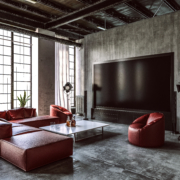What Do I Need For A Home Cinema?
With technology progressing and the advancement of the internet, going to the cinema has gradually become tedious and insignificant. With OTT media services such as Netflix, Amazon Prime Video, Hulu, Disney+ and Now TV, most people prefer to watch movies from the comfort of their own homes. Whether you have a dedicated room or you’re planning to convert your living room into a home cinema. This article will provide you with information on creating the best home cinema experience. What do I need for a home cinema?
Creating a Cinema room
If you’re dedicating a room for your home cinema, rectangular rooms are the better choice in comparison to square rooms. Square rooms are not insurmountable however, achieving good acoustics become a more complex job.
If you wish to have tiered seating, we’d recommend you consider the number of people you want to fit in the cinema, the screen size, seat positioning and ceiling height.
Projectors
When it comes to projectors there are a lot of specs to take into consideration before making your purchase: DLP or LCD, 1080 or 4K, Lumens, Laser or lamp-based, Short-throw, zoom lenses, projection size…. And many more. However, the most important things to consider are image quality, set up requirements and price. If you wish to have a projector it’s important to consider ambient light in your room. If the home cinema has a lot of natural light and white walls, this will bring and reflect a lot of light from outside and severely degrade the image quality of your projector. Darker colours and blacked out curtains will keep the room dark making your home cinema experience that much better.
Positioning your projector
Where you mount the projector can be one the hardest decisions in your planning. The positioning of your projector depends on several factors such as room size, heat & noise produced by the projector. Some of the bigger, high-end projectors are noisy and produce a considerable amount of heat. These should be mounted in the ceiling with heat vented externally or placed in a separate projector space.
Televisions
If you have a low budget or plan on using the living room as a home cinema you may opt for the television option. Televisions do vary in size, with each passing year manufacturers are adapting to the home cinema requirements. One of the most recent releases is a 292” TV by Samsung called ‘The Wall’. As expected, the big screen does come with a cost, the bigger the screen the more expensive it is.
Although the sizes and prices of TV’s has improved over recent years, projectors still have a slight edge over a television due to the versatility of the screen size. With this in mind, you combine a projector and a TV for your home cinema. With a big budget it’s possible to combine both, you could design your home cinema to have a TV behind the projector screen. Ideally the projector screen would have the ability to be rolled out when needed.
Surround Sound
When it comes to watching movies, sound is the main element because it creates an atmosphere. Sound puts you in the characters shoes, it keeps you engaged. Imagine watching a horror film with subtitles only, it’ll last 10 minutes before you pick your phone up. Surround sound is the key to a great cinema room. Surround sound is delivered via speakers located in different arears of the room. Most cinema rooms use 5.1 surround sound systems which use 6 channels feeding into 6 speakers. The speakers are placed in different areas of the room Front Left Right & Centre, Rear Left & Right. In addition, there are more options if you wish to increase the sound quality of your home cinema. Options available 6.1, 7.1, 7.2 and so on. Its important to also understand that more speakers do not necessarily mean better -quality sound. Room size, acoustics and soundproofing can all affect the sound distribution. For example, a smaller room with a 7.2 surround system is likely to ruin your home cinema experience due to frequencies clashing.
Soundbars
The alternative option to surround sound is a soundbar. As previously stated, it’s important to bear in mind (you get what you pay for). Of-course a soundbar is not going to distribute different layers of sound at the same quality as a surround sound system. All soundbars will have at least 2 speakers, some high end soundbars can have 12 or 15 speakers. Nevertheless, a soundbar can still be the best option for your home cinema. Some may opt to have a sound bar due its simplicity and tidiness, setting up a soundbar doesn’t require as many wires as a surround system. It’s important to note the higher end soundbars may come with additional speakers or with the option to add speakers. Majority of the time the additional speakers are wireless, the speakers will still require a power source, but the audio signal is wirelessly transmitted from the soundbar. Depending on room size and space this maybe the better option for your home cinema.
AVR Systems
An AVR (audio/video receiver) is the hub of a home cinema. An AVR is the electronic component that controls and drives your home cinema. To simplify it, all your sources such as DVD players, PC’s, game consoles, satellite/cable TV box, Chromecast, Amazon fire plug into your AVR. From there the AVR sends out audio output to the speakers and the video output to your display. The benefits of having an AVR is that you have a central hub which allows you to control all your sources from a central station. In addition, an AVR has a built-in amplifier which powers your speakers, so if you wish to have a surround sound system in your home cinema an AV receiver is essential.
Cable Infrastructure
Future proof your home cinema by putting aside a modest budget for a good cable infrastructure during the building stage. Although the initial cost may be daunting, the benefits of spending more at installation will save you money when technology inevitably progresses. Wireless connection can be utilized for a home cinema but activities such as streaming films or programmes require the stable bandwidth provided by a wired connection to the internet. Not all cables provide the same quality, hence why some are cheaper than others. For example, CAT6 cables cost 20% more than CAT5. As it provides a larger bandwidth than CAT5, CAT6 cables will give you the option to upgrade your TV to 4K or future upgrades. In addition, a good cable infrastructure is a great investment because it will eliminate the need to rip up all the plasterboards for future changes.





